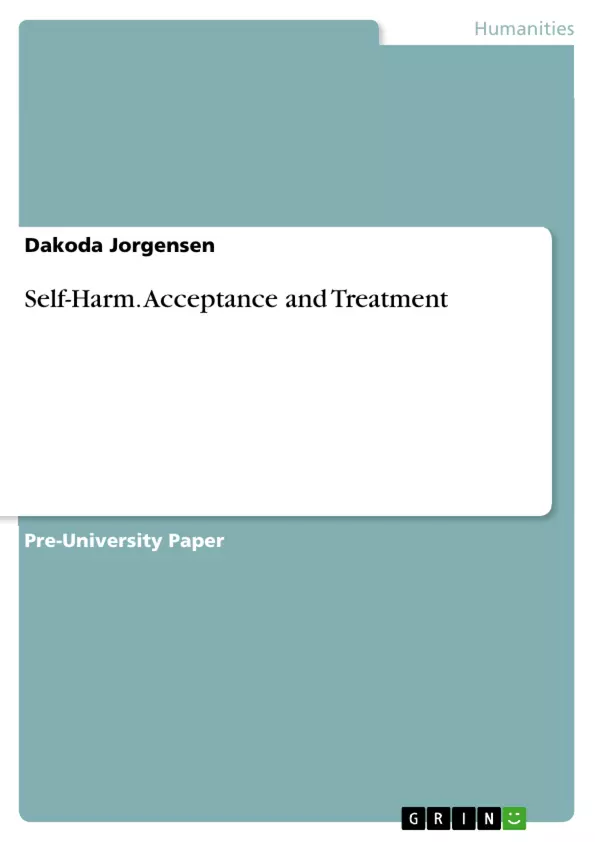This research paper dives into the details of five separate articles that report on the social issue of self-harm. The research was conducted both on and off-line, the off-line research being surveys given to a class of high school students. This paper will explain what selfharm is, the causes, the effects, and the treatment that can be used to help if not cure selfharm.
Contrary to belief, cutting is not the only type of self-harm, unfortunately there are several ways one can hurt themselves in a non-suicidal manner. Burning, scratching, hitting, preventing wounds from healing, and bone breaking are all considered to be parasuicidal (injurious behavior without suicidal intent) actions. The articles suggest that self-injurious behavior is an impulse control disorder that is comparable to an addiction such as cocaine or heroin. It is also suggested that self injurious behavior disorders can be treated, and the victim of the addiction can go on to live a normal life as they learn to control their overwhelming impulses to harm themselves.
Inhaltsverzeichnis (Table of Contents)
- Abstract
- Self-Harm: Acceptance, and Treatment.
- The devil you know is better than the one that you do not.
- The exact cause of self-harm cannot be determined.
- During my research period I took it upon myself to conduct two separate surveys
- If this pattern of neglect continues so many more of our youth are going to have an increased chance of becoming a self-harmer
Zielsetzung und Themenschwerpunkte (Objectives and Key Themes)
This research paper explores the complex issue of self-harm, analyzing five different articles that examine its prevalence, causes, effects, and treatment options. It aims to provide a comprehensive understanding of this often misunderstood behavior and challenge common misconceptions surrounding it.
- The prevalence and impact of self-harm in society, particularly among teenagers.
- The diverse causes of self-harm, including emotional pain, stress, and impulse control issues.
- The importance of recognizing and addressing self-harm as a serious issue, not simply a cry for attention.
- The need for greater acceptance and support for individuals who self-harm, promoting understanding and reducing stigma.
- Effective treatment strategies, such as Cognitive Behavioral Therapy (CBT) and Dialectical Behavioral Therapy (DBT), for managing self-harm tendencies.
Zusammenfassung der Kapitel (Chapter Summaries)
- Abstract: This chapter introduces the research paper's focus on self-harm, outlining its objectives and the sources of information used. It defines self-harm and its various forms, including cutting, burning, and scratching, and highlights the research's emphasis on understanding self-harm as an impulse control disorder.
- Self-Harm: Acceptance, and Treatment: This chapter discusses the prevalence of self-harm, emphasizing its significance in society and the need for greater acceptance and understanding. It challenges misconceptions surrounding self-harm, such as the assumption that all self-harmers are suicidal or seeking attention.
- The devil you know is better than the one that you do not: This chapter explores the psychological and emotional factors that contribute to self-harm. It delves into the concept of "pain or no pain," where individuals may self-harm as a means of releasing emotional pain, finding temporary relief from overwhelming feelings.
- The exact cause of self-harm cannot be determined: This chapter examines the various potential triggers and contributing factors associated with self-harm, including bullying, emotional trauma, and family history. It acknowledges the complexity of the issue and the need for a nuanced understanding of its causes.
- During my research period I took it upon myself to conduct two separate surveys: This chapter details the author's own research methodology, including the surveys conducted among high school students. It presents the findings from both surveys, revealing insights into student perceptions of self-harm and the prevalence of self-harm among their peers.
- If this pattern of neglect continues so many more of our youth are going to have an increased chance of becoming a self-harmer: This chapter focuses on the potential consequences of neglecting self-harm and the importance of prevention and intervention. It discusses the growing popularity of self-harm, the need for increased support groups, and the effectiveness of therapeutic approaches like CBT and DBT.
Schlüsselwörter (Keywords)
This research paper focuses on the critical topics of self-harm, impulse control disorder, parasuicidal behavior, emotional pain, acceptance, treatment, Cognitive Behavioral Therapy (CBT), and Dialectical Behavioral Therapy (DBT). It examines the prevalence, causes, and effects of self-harm, highlighting the need for understanding, support, and effective intervention strategies.
- Quote paper
- Dakoda Jorgensen (Author), 2015, Self-Harm. Acceptance and Treatment, Munich, GRIN Verlag, https://www.hausarbeiten.de/document/295554


